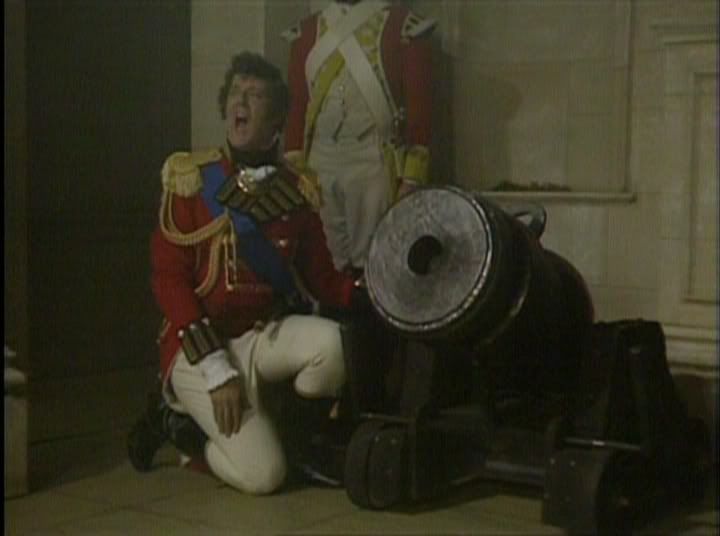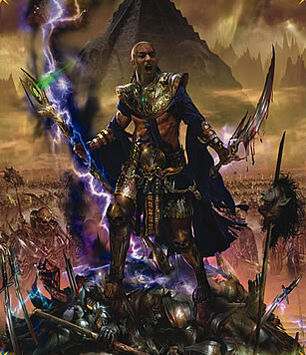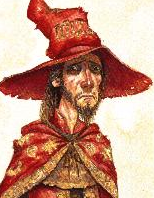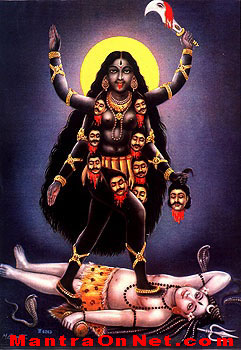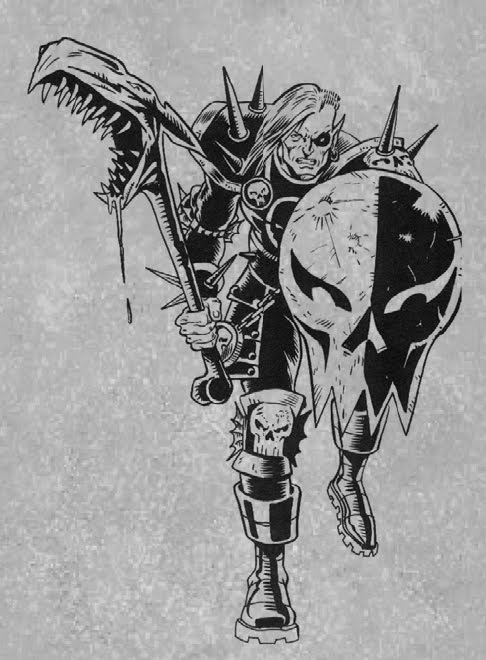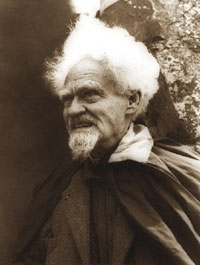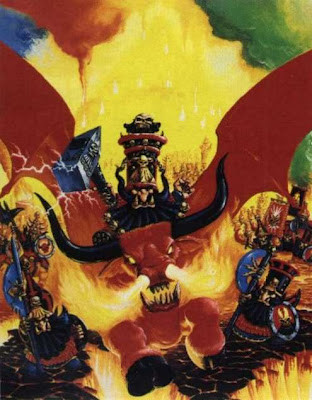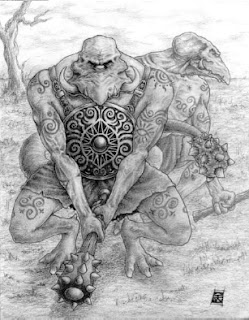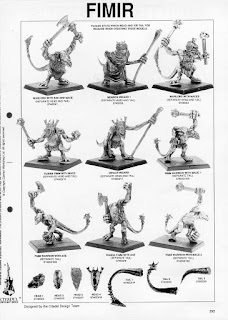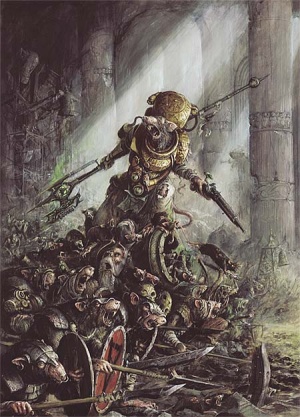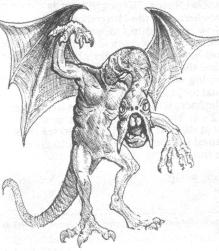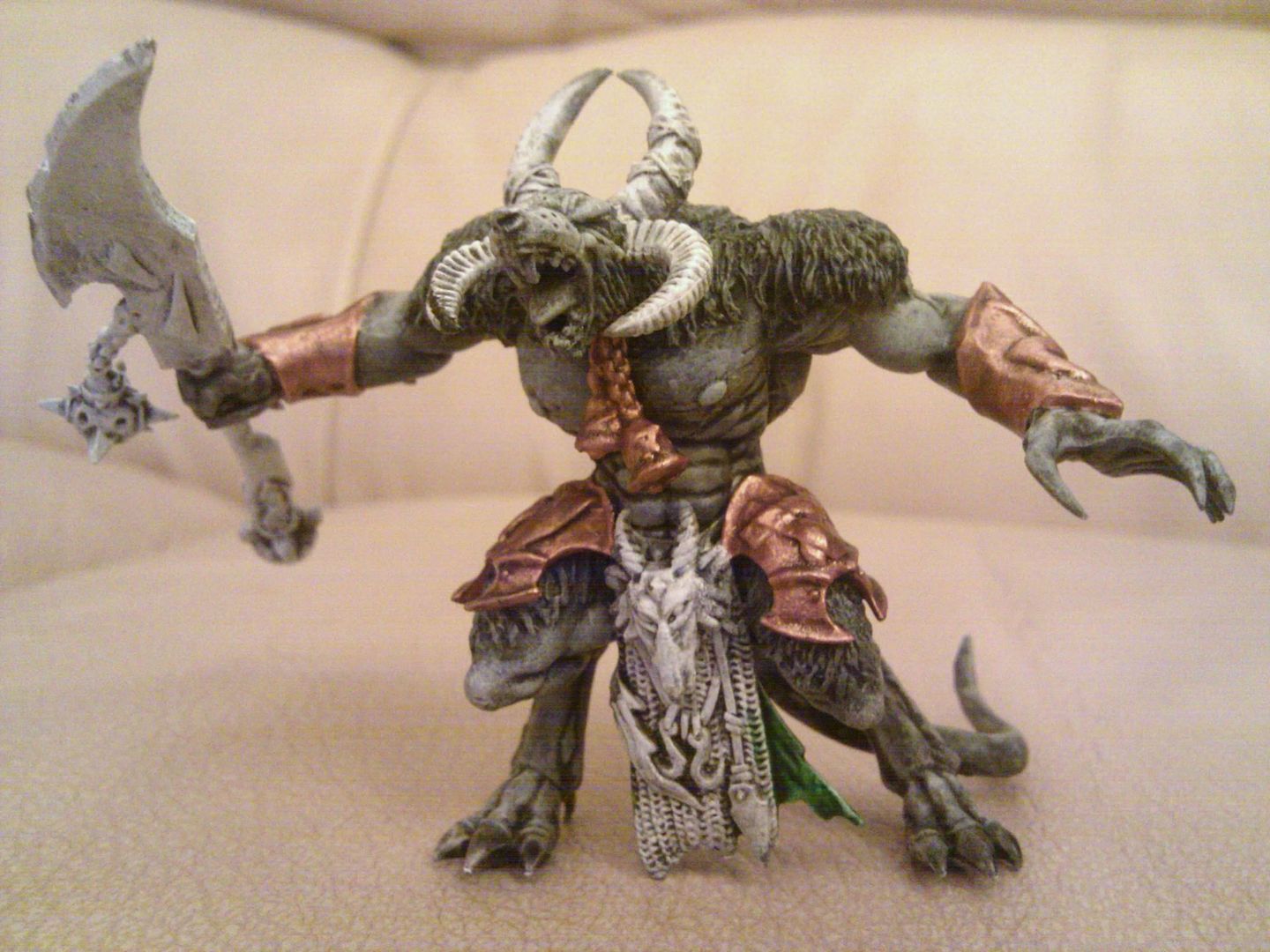The Gamesmaster

One of the strangest things about this chapter, other than the fact that they insist on writing “gamesmaster” rather than “game master,” is the seeming assumption that the GM won't necessarily read the Player's Section. It's chapter 2, and the first page tells you to familiarize yourself with dice, and then directs you to check out more information in the previous chapter. It's just kind of weird. Do they really think a prospective GM will skip the player information? Is that a thing that happens?
That really looks like it isn't just an excessively British witticism, but a frank admission that the book was being written in pieces by the different authors. Remember, this is all done with typewriters and printing blocks to be cut and pasted with actual scissors and actual paste. It was probably literally years between the start of writing and the finished project. That note was probably penned to the other authors, and it is at least as plausible as otherwise that its inclusion in the final book represents a paste-up error.Note: Since it is quite likely that we will be using the word 'gamesmaster' quite a bit in this section, you will find it has been abbreviated regularly to GM. In the long run this will probably save us 10 pages in the book...
So at least some of the back and forth between the chapters represents authors trying to fob off work onto other authors or leave notes for them to get back to things later. Sometimes they never do, as in the case of how in the Player's Section it tells you that the GM will have more information about Fate Points, but they actually don't because the citation is just a circular one that gives no more info on either end.
- Circular Reasoning: See Reasoning, Circular
The Gamesmaster Section is, uh...well, we wouldn't call it that these days. Most of it is just a massive amount of system rules, often the fiddly things like disease, light, traps, Fire!, and stuff that get squeezed into the end of combat chapters in most books. A lot of it is unquestionably of interest to the PCs, like alignment, character advancement and experience, advanced careers, etc. There's some stuff at the end about designing scenarios and creating NPCs, but I think mostly this was called The Gamesmaster section because "Player's Guide" hadn't really come into existence or something yet.
Also stuck in here is the first bunch of color insert pages, which I can't impress strongly enough was uncommon in gaming at the time. Hell, it was still uncommon 3 years later when Shadowrun started doing it. I don't think White Wolf ever had color insert pages. But this was glossy stock back when that shit was reserved for high-end magazines like National Geographic.
The system is, at base, a d100 roll-under system. The GM is allowed and encouraged to load up modifiers however which way he likes, and there isn't really a standardized set of stats to actions to roll against outside of combat (well, there is one, but it's so short and telegraphic that it might as well not exist). So if you need to ride a horse in a difficult situation, you might be called upon to roll against Initiative, Dexterity, Leadership, or Cool. Or something else entirely. And those numbers will probably be very very different. But on top of that, the GM is also supposed to add or subtract bonuses and penalties all over the place, to the point that the system might as well be GM-fiat as to whether you succeed or fail. In actual practice, that's too hard and the lack of sample modifier tables meant that WFRP GMs rarely gave modifiers at all, resulting in most tasks being a simple matter of the GM picking an attribute arbitrarily and the player attempting to roll equal to or less than it on a d100. And since the average stat started at 31, players failed at almost all tasks almost all the time.
Some tests can be two stats added together with another stat subtracted, or just two stats added together. It is possible therefore to have a test have a greater than 100% of success, and the rules don't say what happens. However, the general gist is that most tests are still going to succeed 40% or less of the time. In many ways, having relevant skills was not necessarily a good thing. Having Concealment: Urban gave you a +5% chance to hide while moving. And that's actually worse than not having that bonus in a lot of circumstances, because you are probably going to fail a hiding check even if you are an Elf. So anything that reminds the GM that you might be supposed to roll actual dice is like turning on Yakkety Sax or the Three Stooges soundtrack before declaring what your character is trying to do.
It's hard to say how much of these rules was a distillation of D&D and RuneQuest, but you can definitely see that's where the writers were taking their cues from - it's easy to forget nowadays how weirdly clunky the old systems are (as opposed to how weirdly clunky new systems are); they really were creating all these different rules and guidelines and stuff pretty much in a vaccum, and there's a lot of stuff that's highly individualistic and unintegrated into the general resolution system. Bribery, for example, must go on for an entire column, and deals with everything from minimum bribes to the percentile chances of taking a bribe based on alignment; the same goes for gambling and, yes, even Stupidity.
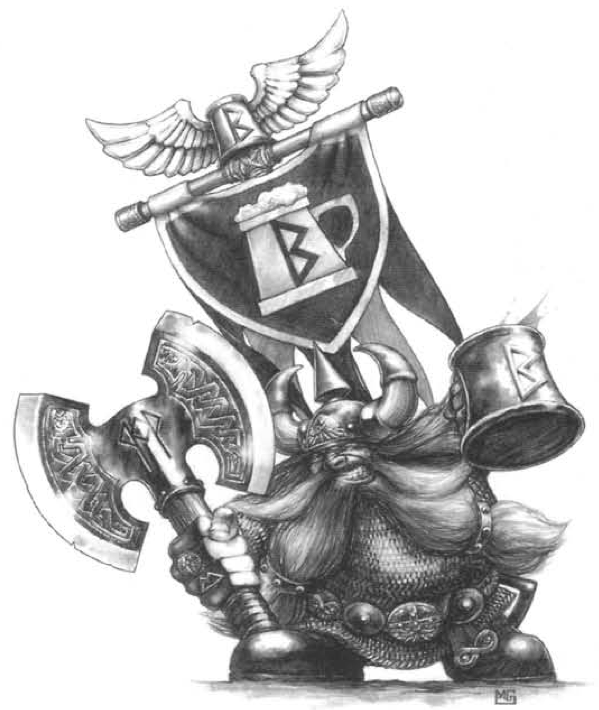
Some of these rules include examples, and the examples include Clem Shirestock. I can't throw stones, I used to do the same thing in my rules examples.
I would fucking kill to get even a page XX error in this shit. It's obvious that there are pointers being written with no idea of what the other parts of the book are going to say, let alone where in the book they are going to end up.Sneak: Although not a standard test, it is anticipated that characters – with or without Silent Moves skills – will want to creep past guards and potential problems. To discover whether the character is heard, refer to the Listen tests above, and the section on Movement.
As it happens, the rules are that good stats help you avoid being seen, but don't do anything to help you avoid getting heard. There's a Hide skill that adds slightly to your chance to avoid being seen, and there's a silent moves skill that subtracts slightly from the chance of being overheard by enemies when you are in their detection radius. There is an “excellent vision” skill, but it doesn't interact with the rules for spotting hidden enemies at all. Instead, it raises the maximum vision range. But Elves have to take Excellent Vision, and the Elf gets their own chart entry on the Vision Ranges table, and I have no idea whether that is supposed to include the Excellent Vision bonus or not. All in all, I think there are enough incompatible ideas about how to handle the stealth minigame that it boils down to literally every single designer on this project having their own system and just writing their sections their own way.
Actual movement involves tables. Very many tables, in fact. On page 73 they give you tables for move allowance at three speeds (Cautious, Standard, and Running) in terms of yards per round/10 seconds, yards per game turn/minute, and miles per hour.

The movement rules go on for 5 pages. The wargame roots of the system are obvious. You also get a couple pages on cutting walls down that go into great detail and on traps, which don't. Traps have a triggering mechanism and a payload, and are mostly handled by magical teaparty. Initiative tests can be called for, but by and large we're dealing with really old school traps where you describe what your characters are doing and the GM decides if this bypasses the traps or not.
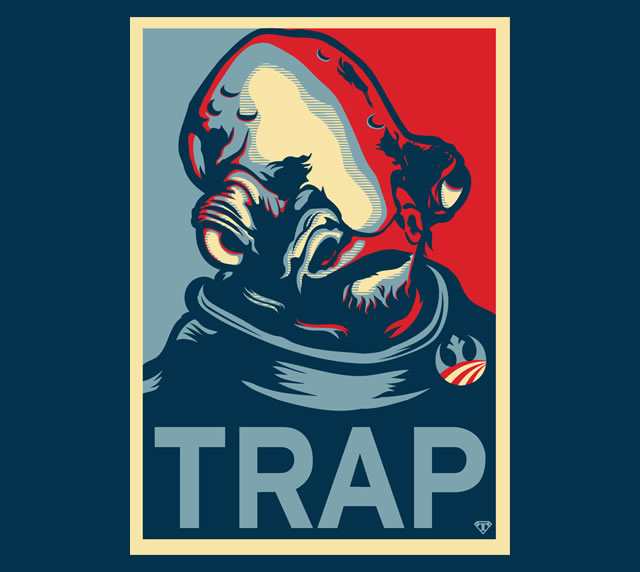
You can tell this system was designed post-D&D because they feel no real need to explain what a trap in the context of a dungeon is. They just assume you to know, and then go on and give you some guidelines for basic traps ripped out of D&D and medieval sieges.
The Fire rules are also refreshingly influenced by old wargame mechanics.
You know what image that goes with, don't you?Burning Oil
Burning oil sticks to skin and clothing and is very difficult to put out. To burning oil everything and everybody is a flammable target - including people! Characters or creatures hit by burning oil suffer 2D4 points of damage, and will be ignited if they take 5 or more damage.
To make Molotov Cocktails, bottles or flasks of oil must be fitted with a rag wick, and count as improvised weapons. They burst into flame only 50% of the time, and attempting to throw one necessitates a Risk test. A failed test means that the contents of the bottle or flask end up all over the thrower, with the usual 50% chance of igniting. Characters carelessly soaked in inflammable oils and spirits count as flammable targets to all fire damage.

No, I'm not posting the other one. You monster.
Psychology is actually a bit more important than the insanity rules suggest, because Dwarfs start out Hating Orcs & Goblins (a holdover from the minis game) and stuff, so there are some essential things to know about your character here.
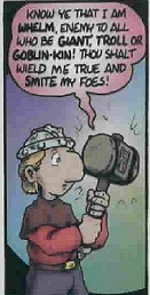
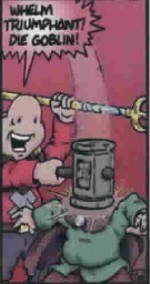
The actual descriptions of what Alignments do and what Alignments characters can have are mysteriously in the gamemaster's section. It has the same five part alignment system that 4e D&D went with, where Law is more good than Good and Chaos is more bad than Evil. But they also tried to do a thing where Law was also bad because it was too extreme, and really Neutral was more good than Good. Or something. But really, it's just a line where Law is on one end and Chaos is on the other, and the forces of Chaos are fucking bad. Chaos is all up on their face eating and raping you with a scorpion dick. It's so unappealing that it only works as comedy, not as horror.

Anyway, despite what they told you in the Player's section, Humans and Dwarves can have any alignment. Elves can only be Lawful or Good. Halflings can only be Neutral. But those restrictions are optional anyway, and I don't understand why they made this have so many onion layers instead of just writing up the alignments and letting players pick one. Or just not have alignments at all, because it seriously makes fuck all difference.
The Lawful/Chaotic thing was supposed to be a big deal, and borrowed much more directly from Moocock than D&D ever did. Later editions of WFRP pretty much simplified down to "Not-Chaos" and "Chaos."

All advancements cost 100 experience points (called “EP” instead of “XP” because fuck you). it takes one advancement to buy a skill associated with your career, and one advancement to buy a stat boost associated with your career, and one advancement to change careers once you have everything in it. That's the whole system, but they take a fuck tonne longer to explain it in this book. You get all the skills for a career if it's your starting career, so careers with a lot of skills (like Outrider with 7 and not at all like Roadwarden with 1) are great as starting careers and shit as things to get into later. I really don't know how the skills that have chances work for non-starting careers. It might say somewhere, but I wouldn't hold my breath.
The advanced careers are pretty hit and miss. Some of them are actual D&D characters like the Wizard and the Templar, while others are just educated dudes. The Artillerist is a guy who can spend advancements to learn how to make and fire catapults. While fascinating, the utility on an adventure is basically nil. Some of these careers appear to character ending. If you become an Artisan you get a random specialty, and if you roll poorly and end up being a chandler you not only don't get any good skills you also don't have any career exits. Wizards are so pimp that they don't even get a writeup in the advanced classes, they have a super double secret class writeup in chapter 4.
According to the Slaver writeup (yes, you can be a Slaver), there are Half-Orcs in this setting. The game contradicts itself on that point a lot.
Half-Orcs wouldn't be fully expunged until Herohammer (WFB 4th edition), I think.
If you did end up in a dead-end advanced career, your options were not terrific:
This is a bit disingenuous as some of the career exits are basic careers already, which makes you wonder if left hand was talking to right hand while writing this.Certain Advanced Careers do not have career exits. Players wishing their characters to advance from these careers should start their characters through new Basic Careers, as described in Changing Careers).
The highlight of the Advanced Careers is that in general they have more and higher profile advancements, and more and better skills. But then again, you also have the Demagogue, who is...well, pretty fucking worthless. Trollslayers get the option to upgrade to Giant Slayer, and in this book that's as far as it gets. Later advancements would introduce Daemonslayers and whatnot, but you can pretty much blame Bill King for that.

Miss you, Bill.
One thing that should be really emphasized at this point is that you get access to many more and better skills involving gunpowder weapons, which is another of those things that really set WFRP off from D&D, where you only got guns if you went through that one shitty adventure that had an alien ship crashland in Greyhawk or something - this was years before Ed Greenwood tried to introduce crappy blackpowder weapons in the Forgotten Realms, and WFRP proudly embraced the European tradition of firearms with all manner of pistols, blunderbusses, bombards, etc. They didn't always work but they were always awesome, and I don't say that just because I dedicated a page of my homebrewed WFRP supplement to dwarf runes for gunpowder weapons.
As NMAth pointed out, there is a top-out to your advancement - you're pretty much guaranteed to rarely go past 3-4 advancements (+4/+40%) in any given attribute, no matter what profile (exception: Wounds), so if you start the game at minimum (30%) you're unlikely to see 70%, and very unlikely to see go beyond that, though certain Skills can help.
The last three pages of the chapter are given over to describing adventure plots, treasure charts, making NPCs, random encounters, and adventuring in the wilderness. It's very old school and very rushed. I don't really know why I'd need a chart to tell me whether a random NPC was a Human, Halfling, Elf, or Dwarf. Especially since Warhammer is a world where NPCs could be Goblins or rat men or whatever. And where African people
were considered to be a different race. It's so half assed and non-encompassing that even though it's really short, it still feels like wasted space.
This is the first real part of the chapter where things feel spaced out weird, mostly because they use the same space-hogging head symbol six times on two pages and the margins between the paragraphs become gigantic. But I've seen worse wastes of space in modern roleplaying books.



